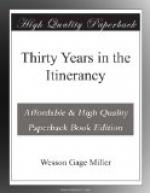During this year Sheboygan was also favored with a revival. Rev. N.J. Aplin, the Pastor, came to Wisconsin during the previous year. He came from Western New York, where he had been engaged in business, bringing a note of introduction from Rev. Moses Miller, my uncle, who had been for several years his neighbor. I employed him at once, for the balance of the year, at Charlestown, a new charge that I had just formed. He was admitted on trial at the ensuing Conference, and appointed to Sheboygan.
After leaving Sheboygan, Brother Aplin’s appointments have been: Manitowoc, Waukesha, Brookfield, Watertown, Beaver Dam, Oconomowoc, Berlin, Geneva, Sun Prairie, Sharon, and Clemensville. At the last named place, he is still rendering the cause effective service. Brother Aplin has been a successful man, and has seen, at various times, extensive revivals under his labors. He is a man who “seeks not his own but the things of Christ.”
At Sheboygan he was assisted in his meeting by Fay H. Purdy, Esq., of Palmyra, N.Y., with whom he had enjoyed an acquaintance in the East. Brother Purdy had already become distinguished as the “Lawyer Evangelist.” Under the united labors of these devoted and earnest men, there was a great quickening in the Church, and though the population of the town was largely German, there was an accession to the Church of forty members.
It was during this Conference year the celebrated Greenbush Camp Meeting was held. The meeting was held in June, 1854. The people came in great numbers, and many of them were fresh from their revivals at home. On invitation, Brother Purdy came to the meeting and brought with him, from Western New York, Rev. Amos Hard, Seth H. Woodruff, Esq., and several others. The meeting was one of great power. Large numbers of professing Christians entered into a new consecration to God, and many souls professed conversion. Throughout the week, the meetings continued to increase in spiritual interest, but culminated in the services of Sunday night. After the close of the sermon, seekers were invited to the Altar. Then followed prayers, singing, and Christian testimony without intermission, until the morning light broke upon the encampment. The prayers of the penitent and the shouts of the saved greeted every hour of the night. The voices of prayer and song did not cease until the meeting was closed on Monday.
Nor did the formal closing of the services in the grove close the meeting. It was now adjourned to the school house in the village, where the services were continued with unflagging interest. But there now came an interchange of labor. Whenever it was necessary to look after domestic affairs, the meeting was left in the hands of others, and on returning its duties were again resumed. Thus by these changes there was no cessation of the meeting throughout Monday, Monday night, and a portion of the following day. This meeting is still referred to with great interest by those who were permitted to participate in its thrilling exercises.




